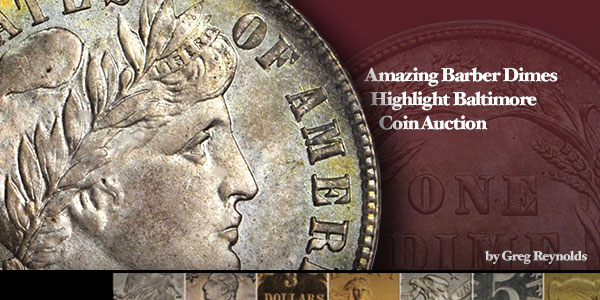
Coin Rarities & Related Topics: News and Analysis regarding scarce coins, coin markets, and the coin collecting community #303
A Weekly CoinWeek Column by Greg Reynolds
The most exciting coins in the upcoming Stack’s Bowers auction are Barber dimes. On Thursday, November 5, these and other valuable coins will be offered in a Rarities Night session at the Baltimore Convention Center, during a “Whitman Expo.” Stack’s-Bowers will auction a wide assortment of items this week, including hundreds of other U.S. coins, rare paper money, and an interesting assortment of world coins.
A highlight of this auction extravaganza is a pleasing and historically important group of medals from the collection of John W. Adams, who is the most famous and accomplished living collector of American medals. A “1776” U.S. Mint silver medal struck in 1807 (Julian CM-8) depicting Benjamin Franklin, and a beaver, is curious and popular with collectors. An especially choice and rare striking in silver of the 1783 Versailles/Americana medal (Betts #608) is important for historical, artistic and cultural reasons. Most coin collectors, however, are more interested in Barber dimes, as am I.
In December 2014, Legend auctioned Bob Simpson’s set of business strike Barber dimes. A buyer then has consigned quite a few Simpson dimes to this auction. In addition, there will be offered two prize Barber dimes that were recently in the famous “Lily Nicole Collection.” There are also gem quality Barber dimes from other sources, including some superb Proofs.
Business strikes are made by routine or ordinary methods. Proofs are specially made coins that fulfill particular criteria. The current discussion relates to business strike Barber dimes.
In recent memory, the greatest sets of business strike Barber dimes to be publicly auctioned are, in alphabetical order: Duckor, Hugon, Nicole and Simpson. Stewart Blay’s set has not been publicly revealed in detail, though is probably the best intact set of business strike Barber dimes and could possibly be the all-time greatest.
Louis Eliasberg did not put forth much effort in selecting Barber dimes, as he, along with many of the foremost collectors of the past, regarded Barber dimes as too common to devote much time towards collecting. James A. Stack and the Norwebs probably felt the same way. During the middle of the 20th century, leading collectors would seek excellent representatives of key date Barber coins, and not really think much about the others.
Before the 1970s, a classic U.S. coin had to be at least moderately scarce in all grades to command attention at a coin auction. By the late 1970s, however, the culture of coin collecting had changed such that there was considerable emphasis on condition rarity. During the 1980s, there were a growing number of collectors and other coin buyers seeking only gem quality coins, those that grade 65 or higher. To an extent, type coins became more popular than ‘better dates’ in each respective series.
So, a gem quality coin of an issue that is common in grades below 65 could be an important condition rarity if it is rare in the gem range, 65 and higher grades. Gems were intensely demanded during the 1980s.
The idea of strategically collecting gem quality representatives of non-rare coins has remained an important part of the culture of coin collecting in the U.S. The positive and negative aspects of such collecting endeavors are not being explored in this discussion, which focuses upon superb, business strike Barber dimes that will be offered this week.
Mostly during the 1990s, John Hugon assembled separate sets of business strikes and Proofs of all three denominations of Barber coins. Except for a few coins that were certified as grading MS-64, all were PCGS or NGC certified from MS- (or Proof-) 65 to -69, mostly 66 or 67.
The Hugon collection was auctioned by Heritage on Jan. 12, 2005, in Fort Lauderdale. I covered that event for Numismatic News newspaper.
Dr. Duckor’s set of Barber dimes was auctioned in January 2006. The “Lily Nicole” set of Barber dimes was auctioned by Heritage in April 2015.
It is not optimal to rank such sets with a formula that is entirely dependent upon the certified grades of the coins included in each set. Many of the assigned grades are controversial or should be subject to debate among experts. Moreover, from around 1997 to 2007, coin markets and coin collecting were influenced by a forceful undercurrent of grade-inflation and coin doctoring regarding classic U.S. coins. The certified grades of a large number of classic U.S. coins changed during this period. Many individual coins had been re-submitted to PCGS or NGC on multiple occasions.
It is important to think beyond the grades indicated on the plastic holders. Indeed, it is imperative to carefully focus on the relative originality, eye appeal and physical characteristics overall of individual coins. If not modified, great coins stand the tests of time. There are very few people who have paid more attention to great Barber dimes than I have.
Indeed, I have been very interested in Barber dimes since my grandmother gave me some when I was five years old. I could not afford to collect gem quality Barber dimes when I was a kid. I viewed gems on occasion, however, while I was collecting circulated Barber dimes. I then enjoyed Barber dimes in AG-03 to Fine-12 grades. I have been a Barber dime enthusiast ever since.
Although the design of Barber dimes is not among the most beautiful of all coin types, Barber dimes tend to tone well. When stored by collectors during the last century, circulated Barber coins tended to tone pleasing shades of gray and russet, often with touches of blue, sometimes with apricot or orange-russet patches.
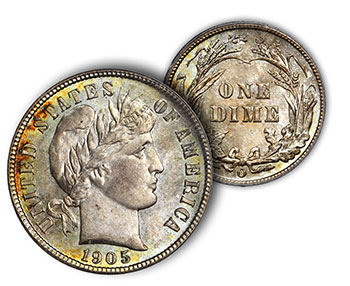 Many uncirculated Barber coins were kept in National Coin albums, which were marketed by Wayte Raymond. Hundreds of Barber coins stored in this manner have toned terrific blue, green, orange and amber colors, frequently including streaks of red. Raymond National Albums and other cardboard albums that were used to house Barber coins during the 20th century strongly contributed to the quality and colorful nature of many of the high grade coins that survive.
Many uncirculated Barber coins were kept in National Coin albums, which were marketed by Wayte Raymond. Hundreds of Barber coins stored in this manner have toned terrific blue, green, orange and amber colors, frequently including streaks of red. Raymond National Albums and other cardboard albums that were used to house Barber coins during the 20th century strongly contributed to the quality and colorful nature of many of the high grade coins that survive.
A substantial number of the Simpson, Nicole, Blay, Duckor and Hugon Barber dimes are incredibly cool. People who are accustomed to seeing Barber dimes that grade below MS-64 are likely to be mesmerized by viewing many of these.
I have been examining gem quality, classic U.S. silver coins often during the past quarter-century, including the inspection of thousands in epic auctions. I attended the sales of the classic U.S. silver coins in the Floyd Starr, Eliasberg, Pittman, Gene Gardner and Eric Newman collections, among many others. (Please click on words in blue to access articles that provide background information and relevant references.)
What are Barber Dimes?
Like Barber quarters and Barber half dollars, Barber dimes were designed by Charles Barber. He designed Liberty Head nickels as well. Charles Barber also designed or co-designed several commemorative U.S. coins and medals.
The Liberty nickel design is dramatically different from the designs of Barber dimes, quarters and halves. Liberty nickels were minted for circulation from 1883 to 1912. It is not clear when Proof 1913 Liberty nickels were struck, possibly late in 1912.
Barber dimes and quarters were minted from 1892 to 1916. For some reason, there are no 1916 Barber halves, as the series of Barber halves ended in 1915. The heads of Miss Liberty that appear on the designs of Barber dimes, quarters and halves, respectively, are extremely similar.
Barber dimes have the legend, ‘UNITED STATES OF AMERICA,’ on the obverse (front). This legend appears on the reverse (back) of the designs of Barber quarters and halves. The reverse design of Barber dimes is extremely similar to the reverse design that was employed on Liberty Seated dimes from 1860 to 1891. The reverse designs of quarters and halves are different matters.
A set of Good-04 grade, business strike Barber dimes, including all dates (and corresponding mint locations), could surely be assembled for less than $2000, maybe even for less than $1500. Barber dimes in EF-40 to AU-50 grades are good values, in my view, provided that the buyer selects coins that score highly in the category of originality, with pleasant toning. An especially appealing set in Extremely Fine-40 grade would probably cost more than $10,000, though surely less than $16,000.
Each Denver Mint coin has a ‘D’ mintmark. An ‘O’ mintmark signifies New Orleans and an ‘S’ refers to the San Francisco Mint. Philadelphia Mint dimes were not struck with a ‘P’ mintmark until 1980. Philadelphia Mint Barber dimes never have mintmarks.
Simpson 1895 Philadelphia Mint Dime
The Simpson 1895 is one of three 1895 dimes that are each PCGS graded as MS-67. There is another that is PCGS graded as “MS-67+.” NGC reports one as grading MS-67 and another has having been graded as MS-68. I would be surprised if any of the others is superior to the Simpson coin.
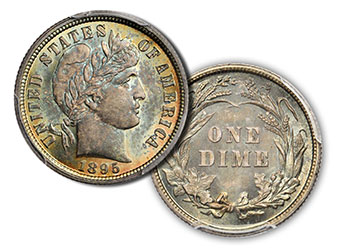 Before January 2005, PCGS and NGC together had certified just two as MS-67 and zero as MS-68. So, in terms of 1895 dimes that are certified by PCGS or NGC as MS-67, MS-67+, or MS-68, there were two in January 2005 and there are six now. Superb Barber dimes rarely just appear. This change in certification data is circumstantial evidence of grade-inflation.
Before January 2005, PCGS and NGC together had certified just two as MS-67 and zero as MS-68. So, in terms of 1895 dimes that are certified by PCGS or NGC as MS-67, MS-67+, or MS-68, there were two in January 2005 and there are six now. Superb Barber dimes rarely just appear. This change in certification data is circumstantial evidence of grade-inflation.
Was the Simpson 1895 the sole PCGS graded MS-67 coin in 2004? According to the Legend Auctions catalogue of the Simpson dimes last year, Simpson acquired this coin in 2011. It would be interesting to learn about its history before 2011.
Hugon’s 1895 dime was PCGS graded as MS-67. It brought $46,000, an extremely strong price in January 2005. The Simpson coin is superior.
The Hugon 1895 was later graded as “MS-68” by NGC. In January 2007, it brought $37,375 in a Heritage auction.
The Simpson 1895 is more attractive than the Hugon 1895. The russet tinted face of Miss Liberty contrasts wonderfully with dynamic, pale green outer fields and lively, rich green inner fields. There is some medium blue color on Miss Liberty, too. This coin is fabulous, seriously.
The grade of the obverse, by itself, makes it into the low end of the 68 range. The reverse is not quite as impressive. The obverse, though, counts for two-thirds of a coin’s grade, in my view. A conclusion that the overall grade is in the middle to high end of the 67 range should not be controversial at all. The Simpson 1895 is one of the most important business strike Barber dimes.
Simpson 1896-S
The Simpson 1896-S is a certification rarity. The SBG catalogue indicates that it is the only 1896-S dime to be PCGS graded as “MS-66+.” None have been graded higher by PCGS.
Contact marks near Miss Liberty’s eye and a few other imperfections keep this coin from meriting a MS-67 grade. It has the eye appeal that experts would associate with a 67 grade. Moreover, the reverse, by itself, would almost grade MS-68! The Simpson 1896-S has wonderful colors and the toning is indisputably natural. It is awesome.
Although the Simpson 1896-S is better, the Gardner 1896-S is close in quality. The PCGS graded and CAC approved, MS-66 1896-S Gardner piece brought $6462.50 on Oct. 27, 2014 in the Gardner II event. It was in a holder with an old blue label (‘insert’), perhaps dating from around 2000 or 2001? The Gardner 1896-S dime had earlier been in the Heritage Long Beach auction of June 2005. It then realized $9775!
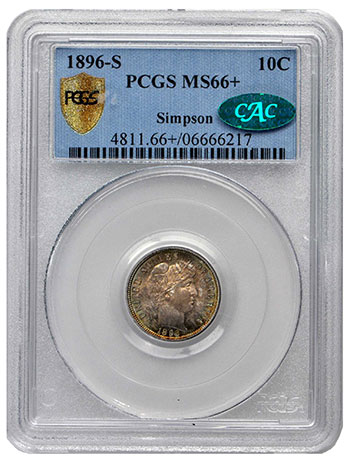 The auction record for an 1896-S dime was set in January 2003 when Heritage auctioned this same Simpson dime, years before Simpson owned it, for $19,550. This 1896-S dime was then PCGS graded as MS-66 and was still in a pre-1990 holder, a “rattler.” It has thus had the same grade assignment from PCGS for more than a quarter-century.
The auction record for an 1896-S dime was set in January 2003 when Heritage auctioned this same Simpson dime, years before Simpson owned it, for $19,550. This 1896-S dime was then PCGS graded as MS-66 and was still in a pre-1990 holder, a “rattler.” It has thus had the same grade assignment from PCGS for more than a quarter-century.
A Heritage cataloguer then noted that this was one of three that was PCGS graded as MS-66, with zero graded higher than MS-66, as of late 2002. There are now eleven reported by PGCS as grading MS-66, not including the Simpson coin, which is graded “MS-66+.” Has there been grade-inflation in regard to 1896-S dimes?
Grade-inflation may have contributed to the fact that this same coin sold for $19,550 in January 2003 and for $7637.50 in December 2014. Bidders may now be influenced by the report of eleven 1896-S dimes being PCGS certified as MS-66 and fifteen being NGC certified as MS-66, plus one NGC graded as “66+.”
The Simpson coin and the Gardner 1896-S are the first and second finest, respectively, known to me. The Duckor piece, which is also PCGS graded as MS-66, brought $7475 in January 2006. The Duckor 1896-S does not have the eye appeal of the Simpson coin. The auction reserve this week for the Simpson 1896-S is $8225 (=$7000+17.5%).
“Lily Nicole” and Simpson 1905-O Dimes
This auction features both PCGS graded “MS-67+” 1905-O dimes! Both coins are CAC approved. These are the Simpson and “Lily Nicole” 1905-O dimes.
It is sometimes forgotten that experts at CAC ignore the plus aspect of coins that have received a plus grade from PCGS or NGC. In another words, if an already certified MS-67 or “MS-67+” coin receives a green sticker, experts at CAC will not reveal whether they figured the coin’s grade as being in the middle or in the high end of the 67 range.
A certified “MS-67+” grade coin is just as likely to receive a sticker as the same coin would be if it was certified as “MS-67” without a plus. In another words, a green sticker does not indicate that experts at CAC agree with the plus aspect of a plus grade assigned at PCGS or at NGC.
I grade both the Simpson and “Lily Nicole” 1905-O dimes in the middle of the MS-67 range. Disagreements regarding a third of a grade increment are hardly unusual. Though true 67 grade coins, neither is as awe-striking as several of the other Barber dimes that were in the Simpson and “Lily Nicole” sets, respectively.
In March 2008, while PCGS graded as MS-67, the “Lily Nicole” 1905-O brought $9200. No coin received a plus grade from PCGS until March 2010. By April 2015, it had received a plus grade and was sold along with the rest of the Lily Nicole set. The Nicole 1905-O then brought $8812.50. Markets for rare U.S. coins in general were faring better in March 2008 than they have over the last six years.
The Duckor coin is different from the Simpson and Lily Nicole 1905-O dimes. The Duckor 1905-O is PCGS graded MS-67. It sold for $10,925 in January 2006.
The obverse of the “Lily Nicole” 1905-O is marvelous. There are wonderful shades of green in the obverse outer fields, which contrast well with the light brown-russet head of Liberty. Furthermore, there is much cartwheel luster on both sides. It is unlikely that this coin was ever cleaned or dipped.
Although the obverse of the “Lily Nicole” 1905-O is more attractive than that of the Simpson 1905-O, the reverse of the Simpson coin is much more attractive than the reverse of the Nicole 1905-O. The Nicole 1905-O scores a little higher in the technical category. Overall, they are both incredible coins. These two and the Duckor piece are probably the three finest of this date. The Hugon 1905-O dime is not quite as impressive.
Simpson 1907-D
The highest quality business strike Barber Dime in this auction is the Simpson 1907-D. It is PCGS graded “MS-67+” and is CAC approved, though it is superior to most other Barber dimes that are also PCGS graded as MS-67+.
If not for a small number of microscopic contact marks on the reverse, and extremely light hairlines on Miss Liberty, this coin would certainly grade MS-68! It already has a level of eye appeal that experts would associate with a solid MS-68 grade Barber dime. Its overall grade is not far from the MS-68 border.
Though the head of Miss Liberty tends to appear blue in pictures, I remember it as being a russet color, perhaps with faint blue tints. The obverse inner fields feature a terrific blend of green hues. About the legend and periphery, there is more green, along with orange-russet and yellow tones, all of which complement each other in an enticing manner. There is much luster underneath these tones.
The Simpson 1907-D is an exceptionally pleasing coin. A commitment to pay at least $11,750 would be required to buy this coin in the upcoming auction.
Hugon-Duckor-Nicole 1908-D
This 1908-D dime is noteworthy and newsworthy. It was in three of the all-time greatest sets of business strike Barber dimes. Unlike several of the other superb Barber dimes in the Rarities Night session in Baltimore on Thursday, this 1908-D was never in the Simpson Collection.
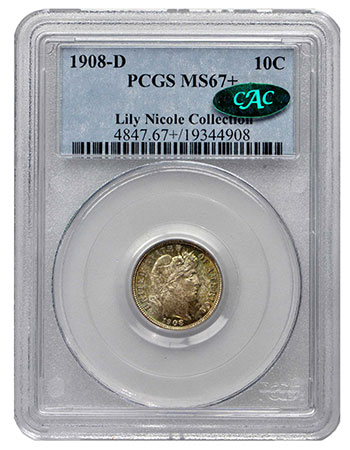 I remember viewing this Hugon 1908-D in January 2005. It then left quite an impression. It has never been cleaned and probably has never been dipped. I figured that the obverse, by itself, grades MS-68. The reverse is not quite as superb as the obverse. I did not grade the obverse as MS-68 this time, though its grade is not all that far away from the MS-68 level. The various green tones naturally blend together in a wonderful manner and there is much underlying original luster.
I remember viewing this Hugon 1908-D in January 2005. It then left quite an impression. It has never been cleaned and probably has never been dipped. I figured that the obverse, by itself, grades MS-68. The reverse is not quite as superb as the obverse. I did not grade the obverse as MS-68 this time, though its grade is not all that far away from the MS-68 level. The various green tones naturally blend together in a wonderful manner and there is much underlying original luster.
It was PCGS graded as MS-67 before January 2005. At the Hugon sale, Dr. Duckor bought it for $4140. A year later, this 1908-D was auctioned for $4600. When the “Lily Nicole” Collection was offered in April 2015, this coin went for $5052.50. As of the afternoon of Nov. 2nd, the reserve had been met and the bidding level was at $5170 (=$4400×17.5%). The final price may be significantly higher.
Simpson 1910-D
Certainly, one of the most important dimes in this auction is the Simpson 1910-D. The Simpson and Duckor-Nicole 1910-D dimes are each PCGS graded MS-67 and CAC approved. As much as I like the NGC graded MS-67 Hugon 1910-D, my recollection is that it does not have the eye appeal of either the Simpson or Duckor-Nicole coins.
The Hugon 1910-D is or was NGC graded as MS-67. It brought $5175 on January 12, 2005. Its grade is around the border between MS-66 and MS-67 grades.
The Duckor-Nicole 1910-D realized $16,100 in January 2006, though just $7050 in April 2015 as part of the Heritage CSNS auction. In December 2014, Legend auctioned the Simpson 1910-D for $10,281.25. The current reserve is $8225.
The Simpson 1910-D is cool. Miss Liberty is bright and is surrounded by well balanced green, russet and yellow tones, with tints of other colors here and there. The green outer fields on the obverse and reverse are exceptional. There is a light pale russet tone over a bright central portion of the reverse. There are patches of orange-russet about the reverse periphery. I imagine almost all serious collectors of dimes liking this coin.
Several of the Barber dimes in this auction are truly amazing. There are no implicit comments, however, regarding those dimes in this auction that I have not mentioned here. Prospective bidders are encouraged to consult pertinent experts before spending substantial sums.
©2015 Greg Reynolds





Great review of Barber Dimes! My favorite series in the Barber coins was the Barber Halves! Barber halves fits the design perfectly. The Barber quarter uses the same design but squeezes it in. The mint mark is usually off center because the design was never meant to be used on the size of a quarter. Indeed the Barber dime used a different reverse but the same obverse as used on the quarter and the half! The sale of my Barber Halves at the ANA Heritage auction in 8/10 will go down as one of my favorite coin auctions. It was David Akers who guided me through the Barber series.
I enjoyed your write up. One of my first series that I completed when I was young was the Barber dime series. At that time, I learned how difficult it was to find nice original Barber dimes.
Toned Barber coins are really cool and I feel under appreciated.